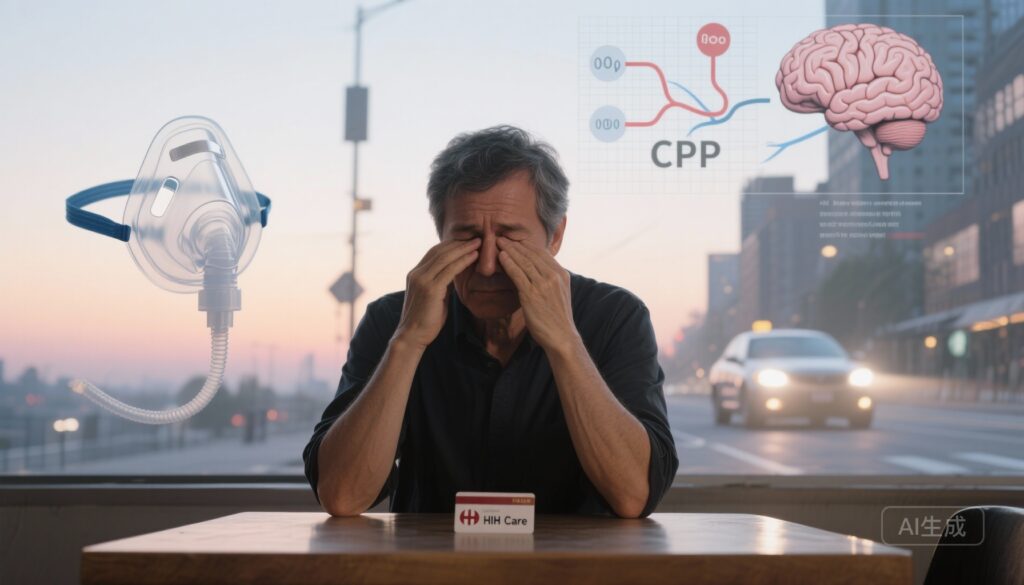Highlights
– Sleep disorders, including insomnia and obstructive sleep apnea (OSA), are highly prevalent in people living with HIV (PLWH), with subclinical OSA reported in up to 70% in polysomnography-based studies.
– Daytime excessive sleepiness (EDS) and cognitive dysfunction are common and impair safety, function, and quality of life; standard OSA therapy (CPAP) has adherence limits and residual symptoms in many patients.
– Modafinil (莫达非尼) is a wake-promoting agent with evidence for improving OSA-related EDS and as an antidepressant augmentation strategy; it may also improve cognition and fatigue in affected PLWH—but HIV-specific randomized data remain limited.
– Clinical use in PLWH should prioritize identification and treatment of reversible contributors (untreated OSA, depression, ART side effects), careful evaluation of drug–drug interactions with antiretroviral therapy (ART), and structured monitoring of efficacy and safety.
Background: the clinical burden of sleep and mood disorders in people living with HIV
As antiretroviral therapy (ART) has transformed HIV into a chronic, manageable condition, attention has shifted to comorbidities that determine long-term quality of life. Sleep disorders, mood disorders, chronic pain and cognitive complaints are highly prevalent among people living with HIV (PLWH) and often cluster together. Published estimates indicate that insomnia and other sleep complaints are substantially more frequent in PLWH than in matched controls: one UK matched study reported a 5.3-fold higher risk of insomnia among people aged 50 and older, while a US study found that women with HIV report insomnia symptoms at a 17% higher rate than HIV-negative women. Polysomnography-based work has also identified a particularly high prevalence of subclinical obstructive sleep apnea (OSA)—reports as high as 70% in some HIV cohorts—raising concern for unrecognized sleep-disordered breathing and its daytime sequelae.
The clinical consequences are meaningful. Daytime excessive sleepiness (EDS) and ‘‘brain fog’’ affect work performance, social participation and driving safety. Mood disorders—reported in 28%–62% of PLWH depending on cohort and measurement—are both causes and consequences of poor sleep, creating bidirectional cycles that are difficult to break. Against this background, clinicians and researchers are exploring adjunctive therapies that can alleviate EDS, fatigue and cognitive dysfunction while being safe in the setting of chronic HIV care.
Study design and evidence base
The literature addressing sleep and mood disorders in PLWH comprises: epidemiologic and case–control studies describing prevalence and risk factors; polysomnography studies measuring OSA and sleep architecture changes; randomized controlled trials (RCTs) of wake-promoting agents in OSA-related EDS (mostly in mixed-population OSA cohorts); and meta-analyses examining modafinil as an augmentation strategy in depression. Direct, large RCTs of modafinil specifically conducted in PLWH remain sparse. The synthesis below integrates population-level data on prevalence and mechanisms with evidence for modafinil’s effects drawn from OSA trials and psychiatric augmentation studies.
Key findings
1) High prevalence and multifactorial drivers of sleep disturbance in HIV
Multiple mechanisms contribute to sleep disturbance in PLWH:
- Viral neurotropism and CNS effects: HIV can cross the blood–brain barrier and disrupt neural and glial function in sleep-regulatory circuits.
- Chronic immune activation: persistent low-grade inflammation—even with virologic suppression—may alter sleep architecture and increase fatigue.
- ART-related effects: certain antiretrovirals (for example older NNRTIs such as efavirenz) have well-described neuropsychiatric adverse effects including vivid dreams, insomnia or somnolence.
- Psychosocial drivers: stigma, socioeconomic stressors, anxiety and depressive disorders frequently co-occur and worsen sleep quality.
2) OSA and EDS are common and clinically consequential
Polysomnography-based studies indicate a high prevalence of subclinical OSA in PLWH; estimates up to 70% have been reported in certain cohorts. OSA produces fragmented sleep and intermittent hypoxia, predisposing to EDS, impaired attention, cardiovascular comorbidity and reduced daytime function. Around 40%–58% of patients with OSA experience clinically significant daytime sleepiness; among PLWH, weight gain associated with some ART regimens and chronic inflammation may further increase OSA risk.
Continuous positive airway pressure (CPAP) remains first-line therapy for OSA, with clear benefits for apnea–hypopnea indices and many daytime outcomes. However, adherence is suboptimal in a large fraction of patients and some individuals continue to report residual EDS despite adequate CPAP use. For these patients, adjunctive pharmacotherapy may be considered.
3) Modafinil: mechanism and clinical effects
Modafinil is a wake-promoting agent that differs pharmacologically from classical psychostimulants. Its primary actions include modulation of catecholaminergic transmission—particularly via inhibition of the dopamine transporter (DAT)—and effects on other wakefulness-related systems. Clinically, modafinil produces sustained wakefulness without the intense sympathomimetic peaks or marked abuse liability associated with amphetamines.
Evidence for clinical benefit includes:
- Randomized placebo-controlled trials in OSA populations demonstrating that modafinil significantly improves subjective and objective measures of daytime sleepiness compared with placebo; trial data consistently report favorable tolerability profiles with transient adverse effects such as headache, nausea and insomnia.
- A 2020 JAMA Psychiatry meta-analysis (included in this synthesis) of modafinil as an augmentation agent in major depressive disorder found clinically meaningful improvements in fatigue, hypersomnia and cognitive slowing when modafinil was added to standard antidepressant regimens (meta-analysis across 14 studies, >1,200 patients).
- Evidence from cognitive testing in diverse populations suggests modest improvements in attention, working memory and executive function with modafinil, which may be functionally meaningful for patients with HIV-associated cognitive complaints or ‘‘brain fog.’p>
4) Translational relevance for PLWH and current evidence gaps
Collectively, these data provide a biologically plausible rationale for using modafinil to treat EDS and fatigue in PLWH, and as an augmentation in depression with strong anergia and cognitive slowness. A Chinese clinical trial reported in a national journal observed meaningful improvements in EDS for OSA patients treated with modafinil versus placebo; however, dedicated, well-powered RCTs of modafinil in PLWH—ideally stratified by OSA status, ART regimen, and mood disorder presence—are limited or lacking. Therefore, while extrapolation from OSA and psychiatric literature is reasonable, clinicians should recognize evidence gaps specific to HIV populations.
Expert commentary and practical considerations
Clinical experts emphasize a stepwise approach before initiating modafinil in PLWH:
- Screen and treat reversible contributors: evaluate for untreated OSA with home sleep testing or polysomnography, optimize CPAP adherence, review ART side effects (consider adjusting regimens if implicated), and address comorbid depression and substance use disorders.
- Assess drug–drug interactions: modafinil has pharmacokinetic interactions that can alter concentrations of other drugs. In patients on ART, consult up-to-date interaction resources (e.g., university drug interaction checkers, product labeling, or a clinical pharmacist) to evaluate potential impacts on protease inhibitors, NNRTIs, integrase inhibitors or other co-medications. Adjustments or monitoring may be required.
- Start with conservative dosing and monitor: typical therapeutic schedules in OSA-related EDS use daytime dosing (commonly 100–200 mg once daily); dosing decisions should be individualized and safety monitored for headache, anxiety, insomnia, blood pressure changes, and rare dermatologic or psychiatric adverse events.
- Functional goals and safety: define measurable goals (reduced Epworth Sleepiness Scale score, improved work performance, absence of unintended sleep episodes while driving) and reassess periodically. Patients who drive or operate machinery should receive counseling about residual risk until treatment effect is established.
Limitations, safety and research priorities
Limitations in the current evidence base include the paucity of RCT data specifically in PLWH, heterogeneity in sleep-disorder ascertainment across studies, and limited long-term safety data in cohorts on contemporary ART regimens. Important research priorities are:
- Randomized trials of modafinil in PLWH with documented OSA and/or depression-related fatigue comparing modafinil vs placebo as adjunctive therapy to CPAP or antidepressants.
- Pharmacokinetic studies characterizing interactions between modafinil and current ART agents, with attention to clinical significance and dosing adjustments.
- Longitudinal studies of cardiovascular, psychiatric and functional outcomes with chronic modafinil use in PLWH.
Clinical summary and practical recommendations
For clinicians caring for PLWH with EDS, fatigue or cognitive complaints, a pragmatic approach is:
- Screen systematically for sleep apnea, insomnia, depression and medication side effects.
- Treat OSA with CPAP as first-line therapy and maximize adherence using behavioral and device-based strategies.
- When residual, clinically significant daytime sleepiness persists despite optimized CPAP and reversible causes have been addressed, consider modafinil as an adjunctive therapy after evaluating for drug interactions with ART and setting clear functional goals with the patient.
- When depression with marked fatigue or hypersomnia is present despite antidepressant therapy, consider modafinil as an augmentation option in line with evidence from meta-analytic data, again with attention to safety and interactions.
- Monitor efficacy (sleepiness scores, functional outcomes) and adverse effects regularly; involve multidisciplinary team members (sleep medicine, HIV specialist, psychiatry, clinical pharmacy) when needed.
Conclusion
Sleep and mood disorders are highly prevalent and clinically consequential in people living with HIV. Modafinil offers a mechanistically plausible and evidence-supported option to improve daytime function, mitigate fatigue and support cognition—especially for patients with OSA-related EDS or treatment-resistant depression with prominent anergia. However, HIV-specific randomized evidence remains limited and potential pharmacokinetic interactions with ART require careful management. Prioritizing diagnosis and treatment of reversible contributors, integrating behavioral and device therapies, and using modafinil within a framework of shared decision-making and monitoring can help clinicians address a major determinant of quality of life for PLWH.
Funding and clinical trials
No specific funding source underlies this synthesis. Well-designed clinical trials in PLWH assessing modafinil’s efficacy, safety and drug–drug interaction profile are needed; clinicians are encouraged to consult clinicaltrials.gov for ongoing or upcoming studies.
References
1. Sukumaran L, et al. Understanding and managing disordered sleep in people with HIV. Lancet HIV. 2025.
2. Hoare J, et al. Global Systematic Review of Common Mental Health Disorders in Adults Living with HIV. Curr HIV/AIDS Rep. 2021.
3. JAMA Psychiatry. 2020;77(6):575-590.



